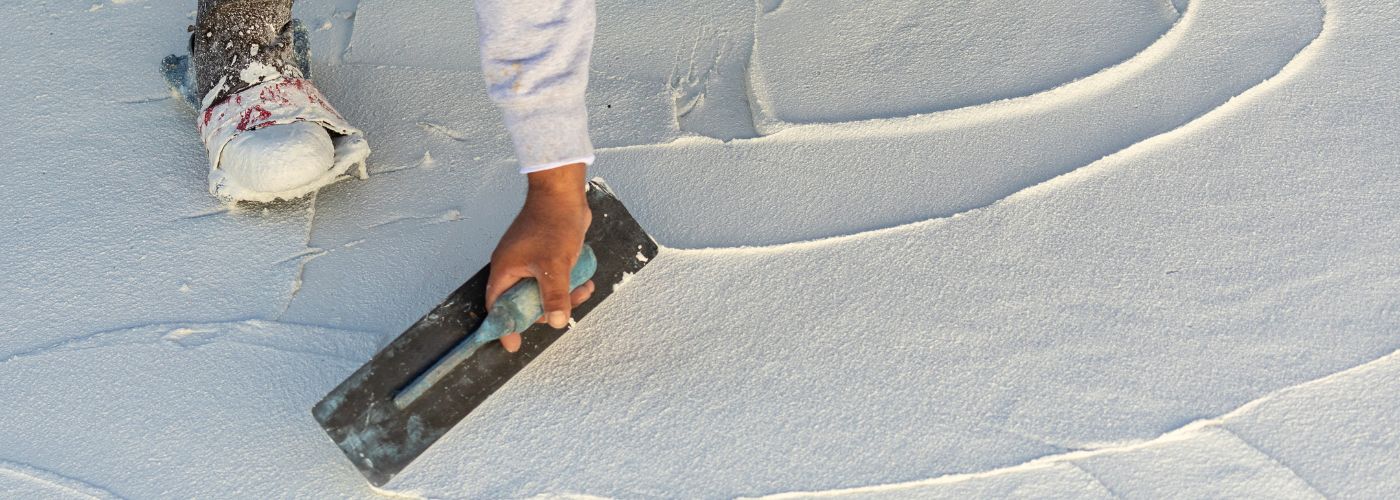If you’re on the journey to rejuvenate your swimming pool or perhaps considering a new one, understanding pool plastering is key to achieving a vibrant and long-lasting pool surface.
Whether you’re considering installation a pool on your property or looking to give an existing pool an upgrade, plastering is an important first step. Let’s dive into the basics and address common questions about this crucial aspect of pool maintenance and renovation!
What Is Plastering A Pool?
Pool plastering is the process of applying a layer of plaster, typically a mix of white Portland cement, water, and marble dust or silica, to the interior surface of a swimming pool. This plaster layer serves as the waterproofing and finishing coat for the pool. It not only enhances the pool’s aesthetic appeal but also provides a smooth and durable surface for swimmers – making proper plastering essential for any pool remodel or design!
The plastering process involves meticulous preparation, including the correct mixing of plaster materials and thorough cleaning and prepping of the pool surface. Once applied, the plaster is smoothed and finished to create a visually pleasing and functional pool interior.
How Soon Can You Swim After Pool Plastering?
One of the most common questions homeowners have after pool plastering is, “How soon can I jump back in?” The curing time for newly plastered pools is crucial. While it might be tempting to take a refreshing swim immediately, it’s essential to exercise patience.
Typically, pool professionals recommend waiting about 7 to 10 days before refilling the pool and resuming swimming activities. This waiting period allows the plaster to cure properly and ensures that the chemicals used in the plastering process have dissipated, creating a safe and enjoyable swimming environment.
During this curing period, it’s essential to follow any specific guidelines provided by the pool plastering professionals. This may include brushing the pool regularly to remove loose plaster particles and aid in the curing process. Remember that picking the right pool contractor is vital to getting your project done safely and correctly!
What Is The Next Step After Pool Plastering?
Once the curing period is complete, the next steps involve balancing the water chemistry and initiating proper pool maintenance practices. Here’s a brief overview of the essential post-plastering steps:
Water Balancing: Test the pool water and adjust the chemical balance to meet the recommended levels. This includes pH, alkalinity, calcium hardness, and stabilizer levels. Proper water chemistry ensures the longevity of the plaster and creates a comfortable swimming environment.
Brushing and Cleaning: Regular brushing of the pool surface is crucial, especially in the initial weeks after plastering. Brushing helps remove any remaining plaster dust and encourages proper curing. Additionally, continue with routine pool cleaning to keep the water clear and debris-free.
Filter Operation: Ensure that the pool filtration system is operating efficiently. Proper filtration aids in maintaining water clarity and preventing the buildup of impurities that could affect the plaster surface.
Start-Up Procedures: Some pool professionals may recommend specific start-up procedures, such as adding sequestrants or other water treatment products. Whether your pool is a custom-design or a classic rectangle-shaped pool, follow any guidelines provided by the professionals to optimize the initial stages of your newly plastered pool.
Can You Retile A Pool Without Plastering?
Retiling a pool is a separate process from plastering, and it is possible to retile without replastering. However, there are important considerations to keep in mind:
Existing Plaster Condition: Assess the condition of the existing plaster. If the plaster is in good shape, and the primary goal is to update the tile, retiling without replastering may be feasible.
Proper Tile Adhesion: Ensure that the new tiles adhere securely to the existing plaster. Proper adhesion is crucial for the longevity and stability of the new tile installation.
Professional Evaluation: Consult with a pool professional to evaluate the condition of both the plaster and the tile. They can provide expert advice on whether retiling alone is sufficient or if plastering is also necessary for optimal results.
While retiling without plastering is possible in certain situations, it’s essential to prioritize the overall health and integrity of your pool’s interior. If the existing plaster is showing signs of deterioration or if there are concerns about its condition, opting for pool plastering along with retiling may be the recommended course of action.
Understanding pool plastering is vital for maintaining a beautiful and functional swimming pool. From the plastering process itself to the crucial steps to take after completion, staying informed ensures that your pool remains a source of enjoyment for years to come.
Whether you’re contemplating a pool renovation or curious about post-plastering care, the key is to approach the process with patience and a commitment to proper maintenance. Happy swimming!




More to Read
What’s Better: Automatic vs Manual Pool Vacuums
Are you tired of spending weekends battling leaves and grime in your pool instead of
Jul
Top Backyard Features For Homes
Are you tired of a bland backyard that doesn’t reflect your personality or lifestyle? The
Jun
How To Prepare For Pool Installation
Are you dreaming of lazy summer days by your own backyard pool? Before diving in,
May